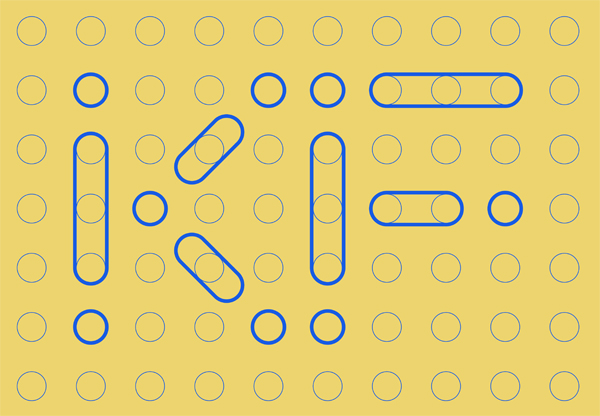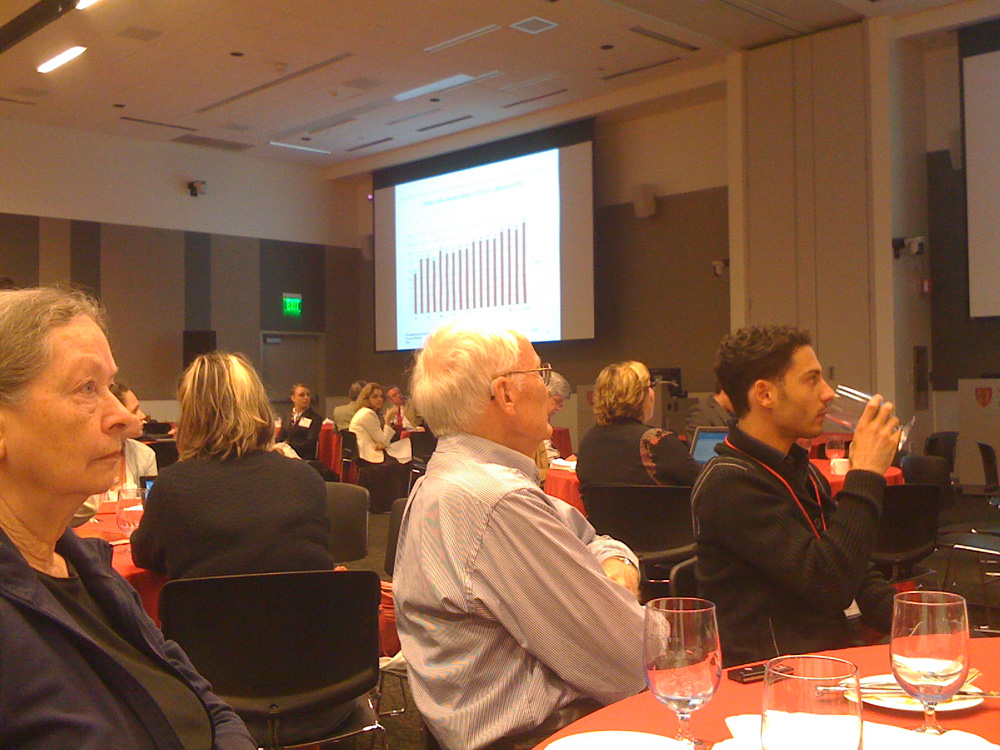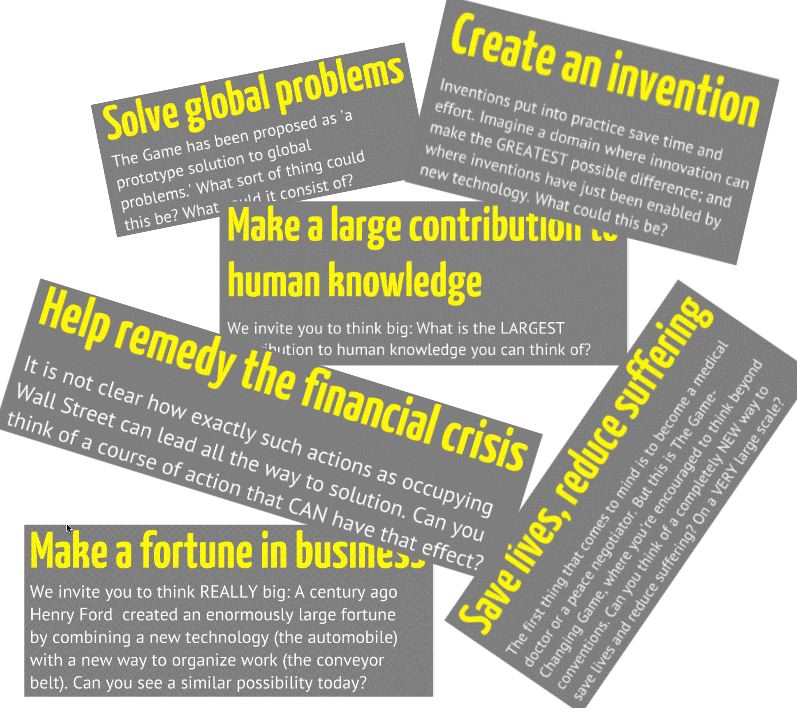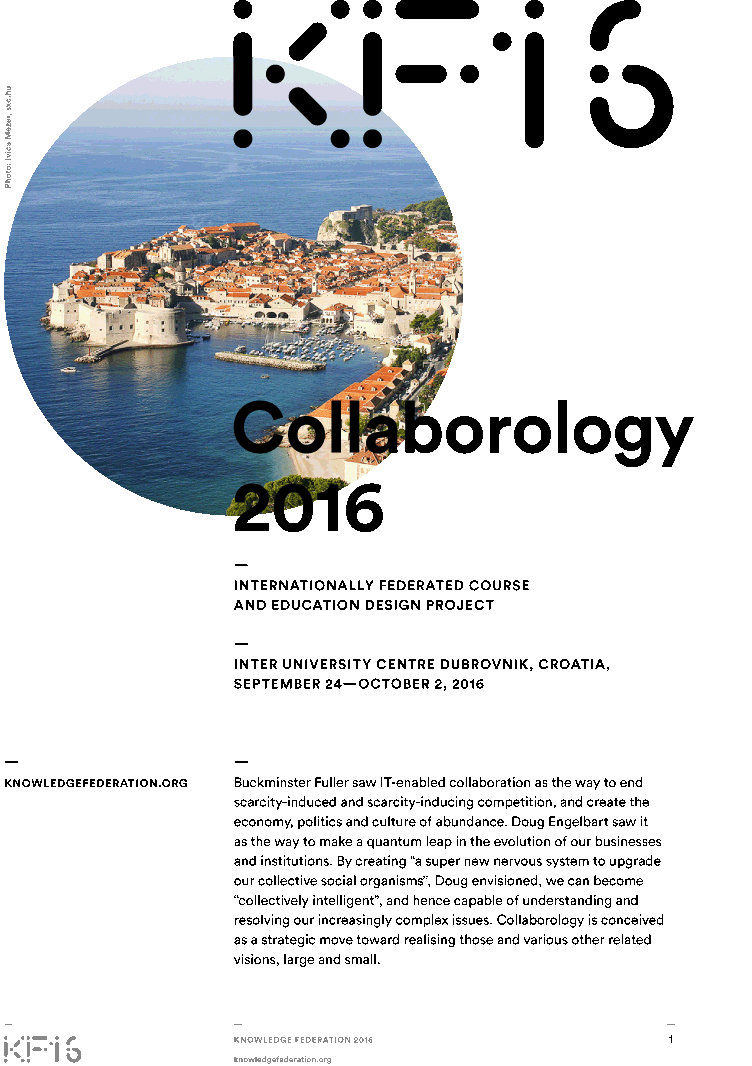APPLICATIONS
Contents
Federation through Prototypes
(Alexander Laszlo, motto of the 57th yearly conference of the International Society for the Systems Sciences in Haiphong, Vietnam, in 2013)
If you've followed me this far—or rather this high up the metaphorical mountain—then you've comprehended that it's a change of self-perception and self-identity I've been guiding you to; and that the all-important next step, the step that takes us into the emerging paradigm and from problems to solutions—is through the metaphorical mirror; by which (having seen ourselves in the world, and comprehended that we are not its "objective observers" but its inextricable part and accountable for it) we become empowered to turn information into action; and importantly—into systemic change. And that's exactly bootstrapping that Doug Engelbart was urging us to engage in; and that's also what prototypes are about. A prototype is a new kind of academic result—which is not telling us how the world is, but designed to be part of the world and interact with it; and make a real difference.
Knowledge federation restores the severed tie between information and action by creating prototypes.
Prototypes are the characteristics products of knowledge federation—as academic books and articles are the characteristic products of the traditional academic work.
A prototype is
- a model, functioning in reality, exhibiting a collection of challenge–solution pairs, or design patterns as we are calling them; and showing how to combine those design patterns in a coherently functioning whole
- an intervention, strategically designed to alter certain conventional practice or system
- an experiment, showing what in the proposed design works well, and what needs to be improved.
A prototype is not complete unless it has a clear and realistic impact model and a deployment plan.
Before I tell you about the knowledge federation prototype, and how we self-organized to become capable of creating prototypes, and before I share some examples of pivotal prototypes we've produced—let me take a moment and introduce a human prototype. I'll tell you why: That all-important first step, through the mirror, has proven to be insurmountably difficult even for the best of us. To be "objective observer", to stay put in whatever systems we've inherited, is so much part of our cultural and especially academic DNA that it takes a veritable leap of faith to pull oneself out of it (perhaps the metaphor of unswamping oneself by pulling one's bootstraps has profounder connotations than even Doug realized).
It is therefore of utmost importance that some academic people have been able to engage in academic bootstrapping; Alexander Laszlo—my friend and knowledge federation colleague and veteran—for instance; who as the President of the International Society for the Systems Sciences, at this society's 57th yearly conference in Haiphong, Vietnam, initiated a self-organization toward "collective intelligence" in this academic community! A salient point (a jewel in my collection of people stories, which I use as breadcrumbs to mark the way to emerging paradigm) was that the event he organized took place less than two seeks after Engelbart died in 2013—feeling that he had failed! At ISSS57 in Haiphong "collective intelligence" and Engelbart's name were on everyone's lips.
Why was it possible for Alexander to undertake what so many of our academic colleagues cannot even think of? Alexander had the rare fortune to be born on the right side of the street, so to speak; his father Ervin observed—already in the title of one of his books—that our collective options are "evolution" and "extinction". Ervin, who is now 91 years old, is a premier systems scientist and The Club of Rome veteran; who—having seen that the technical direction The Club had taken would not reach far enough—initiated The Club of Budapest as its update; to work on the cultural or ethical or "spiritual" ways to solution; Ervin Laszlo was the editor of The International Liberary of Systems Theory and Philosophy, where Erich Jantsch published some of his main works. Alexander's Ph.D. thesis advisor was Hasan Özbekhan, who (as member of Jantsch's 1968 expert team) wrote a 150-page theory of systemic innovation; and also The Predicament of Mankind, The Club of Rome's original statement of purpose. Alexander later collaborated with Béla H. Bánáthy; and contributed to both of his volumes about the dialog.
The knowledge federation prototype is conceived as society's evolutionary organ.
In knowledge
I offer knowledge federation as (a prototype of) the academia's and the society's missing evolutionary organ; and as the strategically first system our self-organization or bootstrapping efforts need to be focused on; which will organize us and empower us—and importantly, our next generation—to foster both the guiding-light knowledge and the systemic innovation as praxis.

Knowledge federation was created in 2008, at the Inter University Center Dubrovnik, by a small group of knowledge media researchers and developers. We realized that the technologies we and our colleagues were developing had the potential to revolutionize society's systems; and that to realize this potential—we would need to self-organize differently. At our second, biennial workshop at the IUC Dubrovnik in 2010, whose title was "Self-Organizing Collective Mind", we invited a couple of dozen of hand-picked experts who would together represent a sufficiently complete combination of expertise; and we invited them to self-organize and form a transdiscipline together.

At our first international workshop, at Stanford University in 2011, within the Triple Helix IX international conference, and in our contributed article, we announced systemic innovation as an emerging and necessary trend in innovation; and (the systemic structure prototyped by) knowledge federation as its systemic enabler.
Here is how we work: A prototype of a system is created, and a transdiscipline around it—to update it and give it real-life impact; according to the state-of-the-art disciplinary and other insights that everyone brings along. Knowledge federation creates the transdiscipline by creating itself.
Today the knowledge federation prototype is a complete prototype of the transdiscipline conceived in terms of about forty smaller prototypes; which models new ways to implement all those various parts and functions that constitute a discipline—ranging from epistemology and methodology to a community of state-of-the-art experts and examples of application.
Our public informing prototype showed how to restore vision to democracy.
In information
You may have noticed that I deliberately spare of you of links; because I want us to be on the same page, and reflect together. The reason why I'll share the link to the video recording of Doug Engelbart's keynote to the Innovation Journalism (a catch-all term that encompasses both journalism that reports on innovation and innovation of journalism) community's fourth conference (at Stanford University in 2007), is that it's a perfect introduction to our public informing prototype; and because it will give you a chance to witness how the elephant in the room remained invisible; and see how a creative mind works; and how the IT revolution really developed; and importantly—the IT revolution's still ignored future. In the video John Markoff (The New York Times technology columnist who authored a book about Engelbart's work and legacy) will introduce Doug; by first excusing himself for saying what everyone in the room knew—namely that while innovation is as a rule incremental, and Silicon Valley's innovation is no exception, "once in a great while there are innovations that change entire paradigms, create new industries and ultimately transform societies. Doug's work, beginning in the 1950s, falls into that category." After Markoff's five-minute introduction, Doug will use about fifteen to elaborate the point of it all. I tested this video on Noah, and he didn't get it (Engelbart was notorious for telling people "you just don't get it!"); even though Noah is skilled at connecting dots and versed in systemic innovation. I had to interpose a translation; which, I feel, you too may benefit from. I am not condescending: I had the rare fortune to not only break bread with Engelbart and the circle of friends and collaborators around him—but to also teach a PhD course about Doug's ideas and legacy; so I can say that I researched him thoroughly.
Doug will open his talk with a warning: The motivations and perceptions that drove him along "all these years" were "large-scale and very conceptual"; Doug spent his life looking at the world from a mountain top—and that's where he's about to take us.
His creative journey began in 1951, when he pondered the basic question "How can I turn my life's career into something that would be most meaningful to mankind?"
And after three months of intense reflection, Doug concluded that humanity's problems were becoming forbiddingly urgent and complex; and that we'll only be able to comprehend and handle them if we do that collectively; and so he made "augmenting" our collective "capability" to deal with complex and urgent problems the focus of his life-long pursuit. (But this was a brief and public story of the IT revolution's inception; a bit longer and private version is that Doug had a proper epiphany—exactly as Tesla did in that park in Budapest; when he saw in intuition the induction motor with rotating magnetic field.)
Don't miss the point of Doug's thought experiment; when he'll ask us to imagine that everyone in the room and the room too grows ten times in size—he'll be making a case for systemic innovation in information; because when the amount of information increases by orders of magnitude, and the speed of events and the complexity of their interaction too—it's not enough to simply grow our old systems in size; "scaling" demands that their structure be thoroughly reconfigured!
When you hear Doug use the words "capability" and "augmentation", be aware that it's his own authentic systemic innovation methodology he'll be referring to; which he published in a SRI report in 1962—six years before Jantsch and others would meet in Bellagio for that purpose! This methodology guided Doug throughout his long and productive career; and led, among other things, to "the personal computing and the Internet" as Markoff pointed out. At some point Doug will flash a slide to explain it; in whose middle you'll see "Capability Infrastructure"; and "Human System" on its left; and "Tool System" on its right. Doug's systemic innovation methodology was conceived as a way to augment human capabilities—both individual and collective. But what is "capability infrastructure"? Consider any human capability, for instance to communicate in writing; clearly this capability depends on certain "tool system" components, such as the clay tablets or the printing press; and on some "human system" components such as literacy and education. But once you do have the capability to communicate in writing—other capabilities, including authoring books and scientific communication, can also be "augmented". All this was meant to introduce Doug's overall main point—which was to invite the journalism innovators to see journalism as part of society's "capability infrastructure"; and to ask—What new capabilities may journalism develop to contribute to society's capability to survive—by taking advantage of (the capabilities of) the new information technology? You'll hear Doug talk about two kinds of capabilities—one of which has to do with our collective "perception" (with spotting problems and contingencies early enough); and the other one with collective "interpretation" (how to collaboratively make sense of bothersome occurrences in a way that empowers us to take care of them effectively). Journalism is such a significant part of our society's 'headlights'; why not adapt it to the core functions it may need to perform in the larger whole? And what about the larger picture; Clearly the journalists cannot do all of this alone. We must collectively become aware "what are some of the social, political, religious [..] holdings that are inhibiting the kind of evolution that the whole organism needs to have for survival". Do journalists interact with sociologists, and anthropologists...
But how does one communicate all this to an audience?
Even when one has been invited as a keynoter; and introduced with a fanfare? You'll see Doug ponder this question aloud; it was clear to him—and it will be clear to you too if you watch this video attentively—that he was not communicating; Doug knew that he never did.
And so went by, without being recognized, this so wondrous opportunity for innovation journalism to comprehend and communicate the point that we the people need to know about innovation; and the Silicon Valley IT innovators in particular—to be able to use the power of new information technology to (help) turn our downward evolutionary course. And not surprisingly; did you notice the irony? The ability to create general insights and principles, and use them as know-how, about any theme including innovation—is not part of our cultural DNA; it is the pivotal "capability" that our "human system" is missing; which must urgently be augmented! Because as the things are now—everyone who lives in "the real world" knows that innovation is driven by the market; not by ideas and principles.
If you watch this entire video—you'll see that it concludes with Doug's recommendation to create a dialog; as a medium where isolated transformative voices like his may remain recorded—and interact and cross-fertilize with other transformative visions and ideas.
So here it is—enjoy the Doug Engelbart show at IJ4.
Coming now to our public informing prototype, which we crafted at our 2011 workshop in Barcelona—this one too has a number of design patterns artfully woven together; so let me here zoom in on those two design challenges that Doug was pointing to—namely to augment our collective "perception" (of all that goes on) and "interpretation" (where we turn things happening into mountain top comprehension and action). We envisioned our public informing prototype as operating within two loops, adjoined together to form number 8 (Mei Lin visualized them as a butterfly's two wings; both necessary to end the society's cocoon stage and enable it to fly). In the prototype the people are empowered to do take part in the lower loop directly; we built this part of the prototype on the pre-existing Barcelona's WikiDiario citizen journalism project, whose creators were part of our team. No less important was to include academic and other experts in the upper loop—so that underlying deeper or systemic causes and remedies to problems don't remain on academic bookshelves, but have a way to impact public comprehension and action; How else shall we the people ever jointly know, I explained in the Liberation book, that for instance "corporate personhood" might be an issue? Here (in the upper loop), knowledge federation's daringly innovative and artistically inspired expert communication design team had the key role of transforming academic insights into something everyone can comprehend (remember what I told you about ideograms). Isn't this how the immersive media technologies will be truly useful to humanity?
Our Barcelona prototype prototyped also a system by which a functional public informing could be created and perpetually re-created.

We were fortunate to have with us Paddy Coulter (fellow of Green College Oxford and director of Oxford Global Media; who was formerly the director of Oxford University Reuters School of Journalism and premier British journalist); who had also been a keynoter at our formative 2010 workshop in Dubrovnik. In the manner of giving the good journalism tradition the reigns, we asked Paddy to chair the Barcelona event.
We techies should not allow ourselves to reinvent journalism.
Our task was to facilitate its evolution—by federating transformative memes. In Barcelona workshop Mei Lin Fung (founder of Program for the Future, a Silicon Valley-based initiative to continue the work on the still ignored parts of Doug Engelbart's vision) represented the Doug Engelbart legacy; David Price (co-founder of DebateGraph, which is the leading collective mind initiative, and of Global Sensemaking, the global community of collective mind researchers and developers) led the technology team. If you listened to Engelbart's talk a bit further, you heard him talk about "structured argumentation" and the challenge of structuring and organizing our collective discourse on society's important themes online; which is exactly what DebateGraph has been so successfully achieving. We used DebateGraph to both document our prototype—and as a core functional element of the prototype.
The game-changing game prototype showed how to empower young people to make a difference.
In empowerment
As an experiment, the prototype we crafted in Barcelona gave us an invaluable insight: When the journalists who co-created it with us returned to their busy editorial desks—they were out of sight! Which led us to an all-important general insight; which merits a paragraph of its own.
When we think about aligning sufficient power to tip the balance and incite any sort of change that will make a difference—we naturally think of the people in power positions; such as political and business leaders, or famed academics. But the people who hold power positions in the existing system don't have the power to change the system. What they, however, can and need to do is empower our next generation—the (normally) young people who are in a life phase where change is natural—to recreate the systems in which they'll live and work.
This empowerment is the duty we have as generation.

And so the following year, at our 2012 workshop in Mei Lin's house in Palo Alto, we crafted a prototype of a system called the game-changing game; and presented it at the Bay Area Future Salon.
The game-changing game is not a game in ordinary sense, but a game-changing way to have a career; where instead of playing by the rules, instead of trying to fit in an existing profession or system—the players undertake to change a system. This initial prototype did have something akin to a game board, available online on DebateGraph; where the players would first be offered a spectrum of (personal and career) Goals (some of which are listed on the above figure); and then brought to the Game Start, from where one could either go to the Vision Quest or the Action Quest. The Vision Quest offered an explanation why the chosen goal—and each of the proposed goals—can indeed be achieved through systemic innovation; the Action Quest offered a medium by which the players could self-organize and create systemic innovation initiatives.
The game-changing game has two categories of players: The A-players (who as graduate students, or entrepreneurs in search of a project) are in a career and life phase where change is natural and easy; and the Z-players (who as professors, or investors) are in positions of power.
The Z-players play the game-changing game by empowering the A-players to pursue their career goals by changing a system.
I published a description of this prototype in the proceedings of The European Academy of Design's yearly conference; which had "Crafting the Future" as title; my contribution had the title "The Game-Changing Game—a practical way to craft the future". Its point being that the natural and arguably only way to "craft the future" was by empowering our next generation to craft the systems in which they'll live and work.
In 2012 in Zagreb we created The Club of Zagreb—a redesign of The Club of Rome based on the game-changing game; the point of which was similar. We had the Europe Club Zagreb as venue; whose windows opened to the Croatian capital’s main square. Yuzuru Tanaka joined us from Japan; Mei Lin Fung, Jack Park and Sam Hahn flew in from California, David Price from England, Alf Johansen from Norway. The A-players were represented by two Croatian student organizations—e-Student (“e” is for “excellence”) and Creativity Club, and by several international ones; Croatian Venture Cup was represented by its director, and academic journalism by its Croatian leader.
With a group of A-players we then took a cosy and bonding minibus tour (sponsored by my mother) through Bosnia and Herzegovina to Dubrovnik; with overnighting in Muslibegović House Mostar and a Sevdalinka garden concert that Ibrica Jusić so graciously gave us. In Dubrovnik we had our third biennial workshop at IUC; and began—with A-players—to co-create what is now the Collaborology education prototype; which is a game-changing game in education.
Collaborology prototype showed how education can be turned into an instrument of change.
In education
A natural way to change course is by changing education.
Education recreates the world with every new generation; unless it is conceived in the traditional way—namely as a way to socialize or condition our next generation to fit into the world.
The collaborology prototype models the education we now need.
By weaving together about half a dozen of transformative design patterns; of which I'll right away highlight this all-important one:
In the collaborology prototype education is by pull, not push.
Which means that the student learns by following his own personal interests and goals—and learning trajectory; and translates into a whole spectrum of advantages, some of which are obvious: Education by push damages creativity and initiative, education by pull enhances them; push education is once in a lifetime, pull education can be life-long and flexible.
The collaborology prototype is a result of almost two decades of evolution; most of which was through an earlier prototype of a transdisciplinary course called Information Design; which we were evolving and teaching at the University of Oslo; which in its developed form had about 100 students. The description of this course model and the enabling technical solutions were discussed and published in suitable international conferences and journals. The domain map object—the core enabling technology this prototype is based on—was a variation on Engelbart's "dynamic knowledge repository" theme.

Both the collaborology course and its predecessor have been conceived as design labs; where the students self-organize in small teams, and create the learning resources for the next-generation students; which has a number of advantages—one of which is that it stimulates collaborative creation for common good (and not studying for the grade).
The collaborology course is, in addition, internationally federated.
Whereby the course becomes, in effect, the game-changing game—where international instructors act as Z-players, empowering teams of A-players to be creative in ways that are well beyond what the traditional education offers; including co-creation of systems.
By enabling each instructor to focus on a single module and corresponding learning resources, and to create them through collaboration with international students including communication designers and media professionals—the collaborology prototype manifests the economies of scale and related advantages that are characteristic of systemic innovation.
The collaborology prototype models a feasible or "sustainable" way to develop and disseminate a transdisciplinary body of knowledge about any theme.
I presented and discussed the collaborology prototype at the conference Future Education, which the World Academy of Art and Science organized in 2017 in Rome; in the session titled "Transition to a New Paradigm in Education", in a talk titled "Systemic Innovation in Education – the Collaborology Prototype". I explained in the abstract:
"Already a half-century ago visionary thinkers observed that the global issues point to a key capability our civilization is lacking – to innovate on the scale of basic institutions and other systems. Think of systemic innovation as updating the gigantic socio-technical ‘machinery’ whose function is to take everyone’s daily work as input and produce socially and environmentally useful effects as output. Consider it the feedback-and-control needed to give our civilization a viable evolutionary course; the flexibility our institutions need to be able to transform under pressure, and not break down. The Collaborology prototype is an intervention to foster the systemic innovation capability through education."

